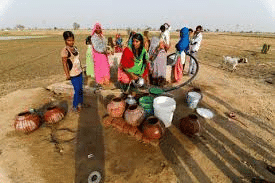UPSC Daily Current Affairs - 1st January 2025 | Current Affairs & Hindu Analysis: Daily, Weekly & Monthly PDF Download
GS2/International Relations
H-1B Visa Program
Source: India Today

Why in News?
The H-1B visa program is in the news due to political discussions about its future. Some influential people, like Elon Musk, are advocating for its continuation, highlighting its importance in filling the STEM talent gap in the United States.
What is the H-1B Visa Program?
The H-1B visa is a non-immigrant visa that permits US-based companies to hire foreign workers for specialty roles in fields such as science, technology, engineering, mathematics (STEM), and information technology (IT). These positions typically require high skills and at least a bachelor’s degree.
- The program was established in 1990 to assist US employers in addressing skill shortages when qualified domestic workers are unavailable.
- A non-immigrant visa allows temporary entry into the US for various purposes, including tourism, business, work, study, or medical treatment.
Visa Duration: An H-1B visa can be granted for a maximum of six years. After this period, the visa holder must either leave the US for at least 12 months before reapplying for another H-1B visa or apply for permanent residency (a Green Card).
Annual Cap and Exemptions: Currently, there is a regular annual cap of 65,000 new H-1B visas issued each fiscal year.
- An additional 20,000 visas are available for applicants who hold a master’s degree or higher from a US university.
- Petitions for H-1B visa holders seeking continued employment and those seeking positions at higher education institutions, affiliated nonprofits, or government research organizations are exempt from the cap.
Dominance of Indian Applicants: Individuals born in India are the largest beneficiaries of the H-1B program, accounting for over 70% of all approved petitions annually since 2015.
- People born in China rank second, consistently making up 12-13% of petitions since 2018.
GS3/Economy
Green Steel Mission: To Help Steel Industry Cut Carbon Emissions
Source: Mint

Why in News?
The Indian government has recently introduced the Green Steel Mission, a detailed plan with a budget of Rs 15,000 crore. This initiative aims to significantly reduce carbon emissions in the steel industry.
Steel Sector in India
- Production: India’s crude steel capacity reached 179.5 million tonnes in 2023-24, with a steady increase in finished steel production, totaling 139.15 million tonnes in the same period. The private sector is the backbone of steel production, responsible for about 83% of crude steel output.
- National Steel Policy 2017: This policy aims to develop a technologically advanced and globally competitive steel industry, with a target production capacity of 300 million tonnes by 2030-31.
- Consumption of Steel: The total consumption of finished steel during April-October 2024 was approximately 75.6 million tonnes, with a per-capita steel consumption of 86.7 kgs in FY23.
Green Steel Mission
The Green Steel Mission is focused on decarbonizing the steel sector to align with India’s net-zero emission goals by 2070.
Key Components
- Production-Linked Incentive (PLI) Scheme for Green Steel: This scheme aims to stimulate the production of green steel, attract investments, and enhance domestic manufacturing of specialty steel, thereby reducing import dependence.
- Incentives for Renewable Energy: The mission includes various incentives to promote the use of renewable energy in steel production, helping to lower the carbon footprint of the industry.
- Mandates for Government Agencies: Government agencies are now required to purchase green steel, which will boost demand and support the transition to more sustainable practices within the industry.
Benefits of Decarbonizing the Steel Industry
- Positive Impact on Global Climate: Reducing emissions from steel production contributes to limiting global temperature rise, aiding in the achievement of climate targets under the Paris Agreement.
- Health and Environmental Protection: Cleaner technologies in steel production lead to lower pollution levels, improving air and water quality. This transition helps reduce negative health impacts on local communities and prevents environmental degradation.
- Job Creation: The shift to green steel is expected to create new job opportunities in sectors such as renewable energy, technology development, and infrastructure.
Related Policies and Initiatives for Promoting Decarbonisation in the Steel Industry
- Task Forces: Fourteen task forces comprising industry, academia, think tanks, and government bodies were established to recommend decarbonisation strategies for the steel sector.
- Steel Scrap Recycling Policy (2019): This policy enhances the availability of domestically generated scrap, promotes a circular economy, and facilitates the establishment of metal scrapping centers for recycling ferrous scrap, including End-of-Life vehicles (ELVs).
- Vehicle Scrapping Policy (2021): This policy increases scrap availability for the steel sector by implementing the Motor Vehicles (Registration and Functions of Vehicles Scrapping Facility) Rules under the Motor Vehicles Act.
- National Solar Mission (2010): This mission promotes the usage of solar energy, contributing to emission reductions in the steel industry.
- Perform, Achieve and Trade (PAT) Scheme: This scheme incentivises energy efficiency improvements in the steel industry.
- Integrating National Green Hydrogen Mission: Announced by the Ministry of New and Renewable Energy (MNRE), this mission supports green hydrogen production, with the steel sector as a key stakeholder. The focus is on producing and using green hydrogen, which is crucial for decarbonising steel production.
- Green Steel Taxonomy: India has introduced a taxonomy for green steel, defining and categorising low-emission steel. This initiative helps create a market for green steel and facilitates financial support for green initiatives.
- Carbon Credit Trading Scheme (CCTS): Notified in June 2023, this scheme aims to reduce emissions across sectors, including steel, through a carbon credit certificate trading mechanism.
- Pilot Projects under the Green Steel Mission: The Ministry of Steel has launched several pilot projects focusing on producing Direct Reduced Iron (DRI) using 100% hydrogen and reducing coal/coke consumption in existing blast furnaces.
Conclusion and Way Forward
Reducing carbon emissions in the steel industry is crucial for combating climate change and ensuring sustainable growth. By prioritising energy efficiency, adopting renewable energy, utilising green hydrogen, and implementing carbon capture technologies, the steel sector can significantly reduce its carbon footprint. Collaboration among the government, industry stakeholders, and research organisations is vital to expedite the transition towards a greener and more sustainable steel industry.
GS2/Governance
Nari Shakti Se Jal Shakti Initiative
Source: DTE

Why in News?
In India, the Nari Shakti Se Jal Shakti initiative is a groundbreaking effort that is leveraging women’s leadership in water conservation.
About
- The Union government launched the fifth edition of the nationwide campaign ‘Jal Shakti Abhiyan: Catch the Rain-2024’ campaign in March, 2024 with the theme ‘Nari Shakti se Jal Shakti.’
- Women-Led Action: Women under this initiative have mobilized communities to adopt water-saving practices, reduce wastage, and protect natural water bodies.
- Sustainability Focus: Women’s leadership ensures the sustainability of water conservation efforts, embedding these practices into community lifestyles.
Significance
- Alignment with SDGs: The initiative directly contributes to achieving the United Nations’ Sustainable Development Goals (SDGs):
- SDG 5: Gender equality and empowerment of women.
- SDG 6: Ensuring availability and sustainable management of water and sanitation for all.
- Empowering Women: It recognizes women as key agents of change, enabling them to lead and sustain water conservation strategies.
Water Crisis Situation
- The global water crisis is escalating, with projections of financial losses in lower-income countries potentially reaching GDP reductions of 15% by 2050.
- India faces a severe water crisis, with nearly 40 percent of its population projected to lack access to clean drinking water by 2030.
- Agriculture consumes about 80% of India’s water and is heavily reliant on unpredictable monsoons.
Government initiatives for water conservation
- National Aquifer Mapping Programme (NAQUIM) to delineate and characterize the aquifer system in the country.
- Jal Kranti Abhiyan, aimed at consolidating water conservation and management initiatives through a holistic and integrated approach involving all stakeholders.
- Atal Bhujal Yojana, envisages improving ground water management in identified water-stressed areas in parts of seven States in the country with emphasis on demand management and community participation.
- Women participation in water budgeting has been kept at least 33% in the Gram Panchayat-level Water User Associations.
- National Water Policy. It advocates rainwater harvesting and emphasizes conservation and direct use of rainfall.
Case Studies
- In Rajasthan, women-led groups have revived traditional water bodies and constructed check dams.
- In Maharashtra, women have played a crucial role in adopting micro-irrigation techniques, reducing water usage in agriculture while boosting crop yields.
- In Himachal Pradesh, women are actively involved in rainwater harvesting projects.
Conclusion
The Nari Shakti Se Jal Shakti initiative demonstrates how women’s leadership can transform water conservation in India, ensuring water security for future generations. This innovative program also fosters collaborations between government bodies, non-governmental organizations, and local communities, creating a robust and sustainable model for water management.
GS 1/History
Shivaji Statue at Pangong Lake
Source: News 18
Why in News?
Recently, a statue of Chhatrapati Shivaji Maharaj was unveiled on the banks of Pangong Tso, located at an altitude of 14,300 feet.
- This event took place shortly after India and China completed their disengagement in the Demchok and Depsang areas, marking the end of a 4.5-year border standoff.
- The statue's inauguration has sparked a debate among army veterans and local residents. Some, like a retired Colonel, have suggested that a statue of Dogra general Zorawar Singh would be more appropriate. General Zorawar Singh led a campaign from 1834 to 1840 that integrated Ladakh into the Dogra kingdom under Maharaja Ranjit Singh.
About Pangong Tso
- Pangong Tso is an endorheic lake situated in the Himalayas at an elevation of approximately 4,350 meters (14,270 feet).
- It ranks among the world's highest brackish water lakes. The lake was formed as a result of tectonic activity during the collision of the Indian plate with the Eurasian plate, an event that also led to the creation of the Himalayas. This collision caused the Tethys Ocean's former space to be occupied by the lake.
GS3/Economy
India Emerges as Global Manufacturing Hub with Remarkable Growth
Source: AIR

Why in News?
India’s manufacturing sector has experienced significant growth this year, highlighting its evolution into a global leader. Key areas of expansion include:
- Toy Exports: Increased by 239%.
- Mobile Phone Production: Surge of 600%.
- Foreign Exchange Reserves: Projected to exceed $700 billion by 2024, ranking India among the top four nations globally.
- Global Innovation Index: India improved its ranking to 39th place in 2024, up from 81st in 2015.
Manufacturing Sector Overview
- Record Exports: Manufacturing exports reached an all-time high of US$ 447.46 billion, reflecting a growth of 6.03% during FY23.
- Rising Middle Class: By 2030, India’s middle class is expected to account for 17% of global consumption, the second-largest share.
- Gross Value Added (GVA): Estimated at US$ 770.08 billion for the first quarter of FY24.
- E-commerce Exports: Projected to grow from US$ 1 billion to US$ 400 billion annually by 2030, contributing to a total of US$ 2 trillion in exports.
- Smartphone Exports: Increased by 42% in FY24, reaching US$ 15.6 billion, with the United States as the primary market.
Challenges Faced by India’s Manufacturing Sector
- Technological Gap: Indian manufacturing is behind in adopting Industry 4.0 technologies such as automation, the Internet of Things (IoT), and artificial intelligence (AI), which impacts global competitiveness.
- Skill Gap: There is a noticeable mismatch between the skills of the Indian workforce and the requirements of modern manufacturing processes.
- Supply Chain Disruptions: The sector’s heavy reliance on imported raw materials and components, particularly from China, makes it vulnerable to global supply chain interruptions.
- Governance Issues: Frequent changes in industrial policies and delays in their implementation create an uncertain environment for investors.
- Global Competition: India faces strong competition from countries like China, where manufacturing costs are lower due to economies of scale and more efficient infrastructure.
Government Initiatives to Boost Manufacturing
- Goods and Services Tax (GST): The implementation of GST simplified indirect taxation and automated tax compliance, reducing the burden on businesses.
- Corporate Tax Reductions: Cuts in corporate taxes, along with streamlined construction permits and the removal of outdated laws, have improved the ease of doing business.
- Foreign Direct Investment (FDI) Policy: Most sectors now allow for 100% FDI, with certain exceptions. For instance, the defence sector permits 74% FDI under the automatic route and 100% under the government route.
- Initiatives like Make in India and Digital India: These programs have enhanced infrastructure and the ease of doing business, supported by various incentives to stimulate domestic manufacturing and attract foreign investment.
- Make in India Mittelstand (MIIM): This initiative, a partnership between India and Germany, aims to drive innovation and strengthen economic cooperation by encouraging small and medium-sized German companies to invest and manufacture in India.
- Japan-India Make-in-India Special Finance Facility: This fund promotes direct investment and trade from Japan to India, including necessary infrastructure development.
- Production Linked Incentive (PLI) Scheme: The PLI scheme has encouraged major smartphone manufacturers like Foxconn, Wistron, and Pegatron to shift their supply chains to India, leading to the production of high-end smartphones in the country.
Future Prospects
- Semiconductor Plants: India has approved the establishment of three semiconductor plants with investments exceeding $15 billion, aiming to strengthen its semiconductor ecosystem and create advanced technology jobs.
- Mega Investment Textiles Parks (MITRA) Scheme: This initiative will develop world-class infrastructure in the textiles sector, enabling the creation of global industry leaders benefiting from economies of scale and agglomeration.
- SAMARTH Udyog Bharat 4.0: This initiative by the Ministry of Heavy Industries & Public Enterprises aims to enhance the competitiveness of the manufacturing sector in the capital goods market through advanced manufacturing and rapid transformation hubs.
GS1/Geography
Vembanad Lake
Source: The Hindu
 Why in News?
Why in News?
The Alappuzha district administration in Kerala is set to launch a large-scale plastic cleaning initiative as part of the Vembanad Lake rejuvenation project. This effort aims to restore the health of Vembanad Lake, which is a Ramsar site and India’s second-largest wetland system.
- Bio-shield: Additional measures include establishing a bio-shield to protect the lake’s ecosystem.
- Interpretation Centre:. Vembanad Lake Interpretation Centre will be set up to educate visitors and locals about the lake’s importance.
- Yarn Museum:. yarn museum will be established to promote local culture and tourism.
- Bottle Booths: Bottle booths will be installed to encourage proper waste disposal.
- Community Tourism: Efforts to promote community tourism will be enhanced.
- Fish Seeds: Fish seeds will be stocked in the lake to boost fish populations.
Awareness programs will be conducted for fishers, houseboat employees, and local residents to highlight the importance of lake conservation.
A study conducted in 2023 revealed the degraded condition of Vembanad Lake, which affects the livelihoods of approximately eight million people. The lake’s water retention capacity has significantly declined by 85.3% from 1990 to 2020.
About Vembanad Lake
- Largest Lake: Vembanad is the largest lake in Kerala and the longest lake in India.
- Wetland Ecosystem: Vembanad-Kol is the largest brackish, humid tropical wetland ecosystem on the southwest coast of India, fed by 10 rivers and typical of large estuarine systems on the western coast.
- Ramsar Designation: In 2002, Vembanad was designated as a Ramsar Wetland of International Importance and is included in the National Wetlands Conservation Programme by the Government of India.
- Bird Sanctuary: The Kumarakom Bird Sanctuary, also known as the Vembanad Bird Sanctuary, is located on the lake's east coast.
GS3/Environment and Ecology
IPBES Transformative Change Assessment
Source: DTE

Why is it News?
A report called "Transformative Change Assessment" by the Intergovernmental Science-Policy Platform on Biodiversity and Ecosystem Services (IPBES) emphasizes the crucial role of governance in preventing biodiversity loss.
- The report highlights that effective governance, which prioritizes inclusivity and sustainability, is vital for safeguarding biodiversity and fostering long-term systemic change.
What are the Main Points of the Transformative Change Report?
- Prevent Ecological Harm: The report underscores the urgent need for fundamental changes in how societies interact with nature to avert biodiversity loss. It warns that failing to act could result in irreversible ecological damage, such as the disappearance of coral reefs and rainforests.
- Economic and Job Prospects: Taking immediate action could create USD 10 trillion in business opportunities and support 395 million jobs worldwide by 2030, particularly in nature-dependent industries.
- Causes of Biodiversity Loss: The report pinpoints the root causes of biodiversity loss as the disconnection between people and nature, domination over nature and others, concentration of power and wealth, and the prioritization of short-term material gains over long-term sustainability.
Five Key Strategies for Transformation:
- Conserve and Regenerate: Emphasize areas of biocultural diversity that merge environmental restoration with cultural values, such as community-driven forest management in Nepal.
- Systematic Change in Key Sectors: Implement sustainable practices in sectors like agriculture, fisheries, and infrastructure that contribute to biodiversity loss.
- Transform Economic Systems: Move towards nature-positive economies by reforming harmful subsidies and promoting sustainable business models.
- Adaptive Governance: Develop governance systems that include diverse stakeholders, such as Indigenous communities, and prioritize biodiversity in policies. Adaptive governance allows for continuous adjustment of strategies based on changing environmental conditions and new information, making it essential for addressing complex biodiversity challenges.
- Shift Views and Values: Foster the recognition of the interconnectedness between humans and nature through education, experiential activities, and the integration of diverse knowledge systems.
IPBES
- Establishment and Purpose: IPBES, founded in 2012, is an independent intergovernmental organization comprising nearly 150 member governments, including India. Its primary role is to provide scientific assessments on biodiversity, ecosystems, and their contributions to human well-being, along with offering tools and methods for their protection and sustainable use.
- Governance: Although IPBES is not a United Nations body, the United Nations Environment Programme (UNEP) offers secretariat services to IPBES. The secretariat is located in Bonn, Germany.
What is Transformative Change and How Can it be Achieved?
- Definition: Transformative change refers to a fundamental and system-wide reorganization involving technological, economic, and social aspects, including paradigms, goals, and values. This reorganization is essential for conserving and sustainably using biodiversity while ensuring a good quality of life and sustainable development.
- Steps to Achieve Transformative Change:
- Carbon-Neutral Actions: Promote carbon-neutrality as a standard for individuals, businesses, and governments, supporting legitimate climate-friendly offsets.
- Earth-Positive Choices: Facilitate and encourage people to make environmentally positive choices by reshaping supply chains and influencing policies.
- Reforming Subsidies: Redirect subsidies and incentives to foster environmental stewardship and transition away from resource-extractive industries toward sustainable practices.
- Precautionary Decision-Making: Implement precautionary, adaptive, inclusive, and cross-sector decision-making to proactively address environmental threats, even in the absence of conclusive evidence.
- Strengthening Environmental Laws: Advocate for more robust environmental laws with consistent enforcement and support for global initiatives aimed at protecting nature and promoting sustainable economic activities.
India’s Initiatives for Transformative Change
- National Biodiversity Action Plan (NBAP):. framework for conservation and sustainable use of biological resources in India.
- Swachh Bharat Abhiyan:. nationwide campaign to clean up the streets, roads, and infrastructure of cities and rural areas.
- National Action Plan on Climate Change:. set of initiatives aimed at addressing climate change and its impacts.
- Faster Adoption and Manufacturing of Hybrid and Electric Vehicles (FAME):. scheme to promote electric and hybrid vehicles in the country.
- Pradhan Mantri Ujjwala Yojana (PMUY):. program to provide LPG connections to women from below poverty line households, promoting cleaner cooking fuel.
- Mission LiFE (Lifestyle for Environment): An initiative to promote sustainable lifestyles that are in harmony with the environment.
- Atal Mission for Rejuvenation and Urban Transformation (AMRUT):. mission aimed at ensuring basic services like water supply, sewerage, and urban transport in cities.
Sustainable Development Goals (SDGs) for Transformative Change
- Focus on sustainable development through inclusive growth addressing various aspects like Life Below Water, Climate Action, Clean Energy, Clean Water, Responsible Consumption, and Life on Land.
- Alignment with India's Initiatives: Various initiatives in India such as the Smart Cities Mission, Green India Mission, Swachh Bharat Abhiyan, Pradhan Mantri Ujjwala Yojana, and National Clean Energy Fund align with the SDGs.
- Renewable Energy Investments: Significant investments in renewable energy, aiming to generate 500 GW from non-fossil sources by 2030, under the leadership of the International Solar Alliance.
|
44 videos|5257 docs|1109 tests
|

















